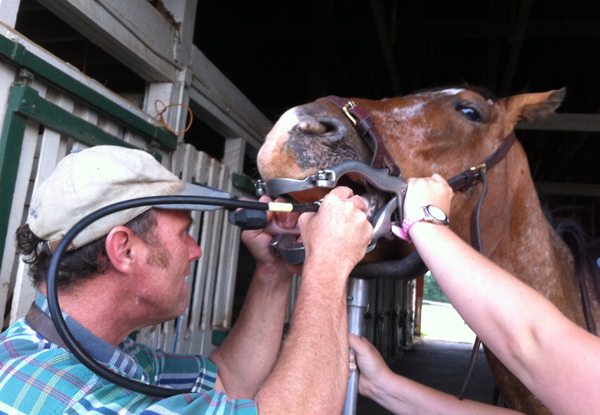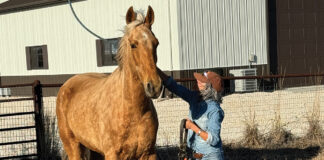
Points, hooks, waves and ramps…they may not sound connected, but all four are common abnormalities that equine dentists regularly address in their four-legged patients.
The horse is a grazing animal with hypsodont teeth, which means the teeth continue to erupt throughout the animal’s life. The teeth have a reserve crown and a long root. In the average horse, the teeth erupt anywhere from two to four millimeters a year.
Dental Appointment
Your horse should have his first dental exam by age two. By this time the incisors are first erupting and the first pre-molars are setting. Dentists often remove “wolf teeth” in young horses, as these teeth can interfere with the horse’s comfort when carrying a bit in the mouth.
After age two, your horse should have an annual oral exam. His teeth may not need floating every year, but he should be checked by the dentist.
“As horses age, their teeth get tougher and stronger,” says Eric Evans, DVM, a veterinarian with Peterson & Smith Equine Hospital in Ocala, Florida, who has been doing equine dentistry since 2005. “Once they’re in their teens and older, they may only need floating every couple years. Older horses don’t develop points as quickly as younger horses, whose teeth are softer.”
Many equine dentists prefer to use mild sedation for an exam and dental work because this keeps the horse from moving his head around too much. To begin the exam, the dentist will visually examine the horse and watch how he holds his head. After rinsing out the mouth to remove any food debris, he/she will palpate the jaw and then manually feel each tooth, typically using a speculum (a type of metal brace) to hold the mouth open.
“I feel every molar and pre-molar for movement, feed impaction and fractures. Any movement of a tooth is abnormal and cues me in to look at this closer to see what we need to do to address it,” says Dr. Evans. “If a tooth is loose or there are any signs of infection—such as bad breath (halitosis), nasal drainage, and/or abscesses—we generally will need to do further diagnostics, which include radiographs. This may lead to having teeth extracted.”
Potential Problems
The horse’s mouth is designed so that the top jaw (maxilla) is wider than the bottom jaw (mandible). When the horse’s mouth is closed, the lower section of teeth (arcade) doesn’t have tooth-to-tooth contact with the outside edge of the top jaw. Because of this lack of contact, enamel points tend to form where the teeth don’t meet. Enamel points are sharp edges that form on the buccal surface (against the cheek) of the teeth, or on the lingual surface (against the tongue). These points can rub against the cheek or tongue, causing ulcerations and pain.
Some horses have abnormalities in the shape of their mouths, such as parrot mouth, in which the upper jaw juts forward.
“Probably 20% of the horses I see have parrot mouth,” says Dr. Evans. “It may be very minor, but since the upper jaw is shifted forward, the back edges of the lower back molars have no tooth surface grinding against them so they develop ramps, meaning they slope up. If a dentist says he ‘floats down the ramp,’ this is what he’s addressing.”
In addition to “enamel points” and “ramps,” other tooth issues include hooks and wave mouth.
Wave mouth occurs when the horse’s cheek teeth (premolars/molars) wear unevenly, causing waves of high and low places—little hills and valleys—along the occlusal surface of the teeth.
Hooks can develop when teeth don’t meet evenly on the top and bottom. Because of uneven wear, hooks can form on the front or back part of a tooth. Hooks are very common in horses with an overbite, or parrot mouth.
To address any of these problems, the dentist uses either hand tools or a power float tool. After smoothing the edges and filing down rough and uneven spots, the dentist should again examine the horse’s mouth visually and manually to be sure all the necessary corrections have been made. The dentist may give the teeth a “bit seat,” which just means rounding the upper and lower second pre-molars to allow the bit to rest comfortably in the mouth without interference from these teeth.
Don’t be alarmed if your horse’s teeth are yellowish or brownish in color. When the teeth erupt, they are covered in “dentin.” In horses, the enamel layer is underneath the dentin, which is just the opposite of human teeth, in which enamel is the outer layer.
“Dentin is a softer material than enamel, which is why the horse’s teeth stain easily,” Dr. Evans explains. “As the tooth wears, you’ll see the white of the enamel, which doesn’t stain as easily as dentin.”
You can tell a lot about the condition of your horse’s mouth just by being an observant owner. Contact your equine dentist if you notice any of the following, as they may be signs of a tooth/mouth problem:
- Dropping feed (“quidding”)
- Bad breath
- Mouthing/chewing the bit more than usual
- Sudden abrupt head movements when being ridden
- Tossing the head frequently
Regular dental care can avoid most problems and keep your horse
comfortable and chewing properly, so he can get the most nutrition out of his feed.
Click here to download a glossary of equine dental terms.






Great article.
I’m interested in learning more about equine dentistry so this article was great!